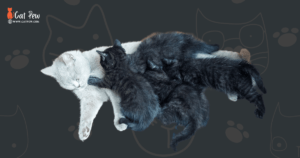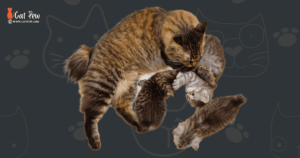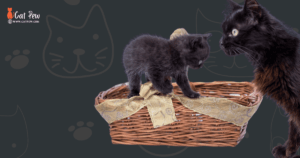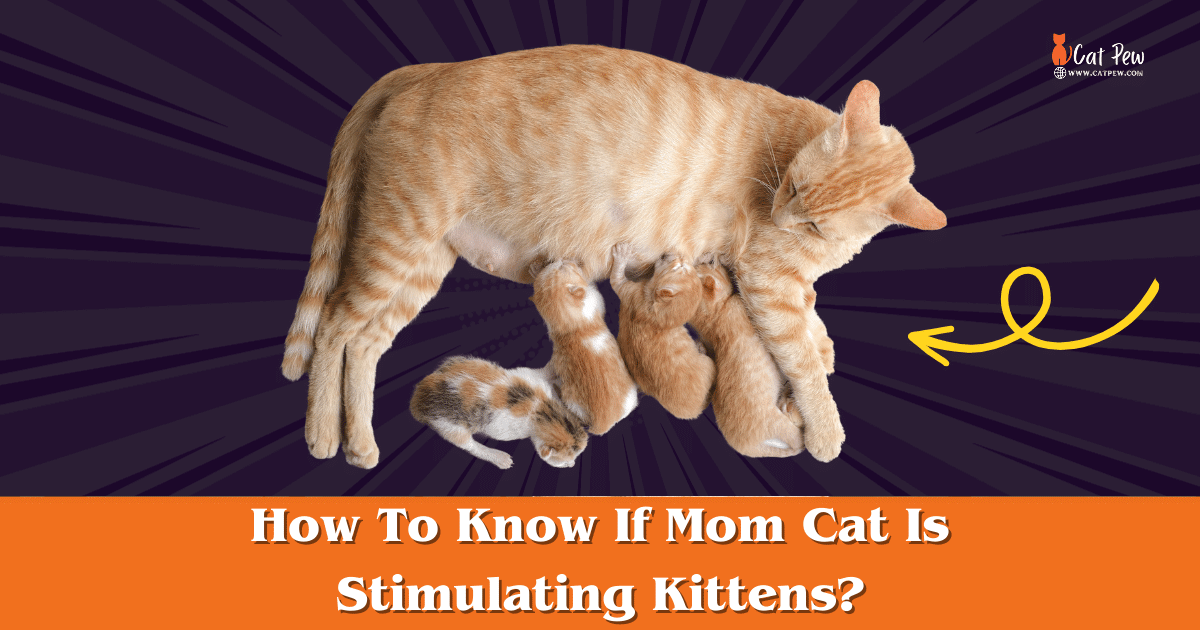To know if a mom cat is stimulating her kittens, observe if she is licking them regularly. This behavior is essential for the kittens’ well-being.
Welcoming a litter of adorable kittens into the world can be an exciting and heartwarming experience. As a responsible pet owner, it is crucial to ensure that the mother cat is properly caring for her newborns. One essential aspect of maternal care is the process of stimulation.
This is when the mother cat uses her tongue to lick her kittens, which serves several important purposes. Not only does it help to keep the kittens clean, but it also stimulates their bodily functions, such as eliminating waste and promoting circulation. Proper stimulation is vital for the overall health and development of the kittens. We will explore how to determine if a mother cat is effectively stimulating her little ones, providing you with the knowledge to ensure their well-being.
Signs Of Kittens Being Properly Stimulated: Understanding Mom Cat’s Behavior

When it comes to the development of newborn kittens, maternal stimulation provided by the mom cat plays a crucial role. Kittens rely on their mother for not only nourishment but also the necessary stimulation that promotes their physical and emotional growth. By observing the behavior of the mom cat, we can gain valuable insights into whether the kittens are being properly stimulated. This article explores the various signs we can look out for to understand the mom cat’s behavior and ensure that the kittens are receiving the care they need.
Importance Of Maternal Stimulation For Kittens’ Development
Maternal stimulation is vital for the overall development of kittens. It helps them learn and adapt to their environment, promotes their physical and cognitive growth, and aids in the development of their social and communication skills. The first few weeks of a kitten’s life are crucial, and the mom cat’s interaction and care play a fundamental role in shaping their well-being.
Observing Mom Cat’s Behavior For Signs Of Stimulation
By carefully observing the mom cat’s behavior, we can gain insights into how well the kittens are being stimulated. Here are some behaviors to look out for:
Kitten nursing and suckling behavior
The mother cat’s presence and the kittens’ ability to nurse and suckle are clear indications that they are being properly stimulated. Kittens instinctively seek their mother’s milk and the comfort it provides. If you notice the kittens eagerly nursing and suckling, it is a positive sign that they are receiving proper care and stimulation.
Mother cat’s grooming and cleaning routine
Grooming is not just about maintaining cleanliness; it is an essential part of maternal stimulation. A mother cat will meticulously groom her kittens, not only to keep them clean but also to provide sensory stimulation. Through grooming, the mom cat helps the kittens develop their sense of touch, strengthens their bond, and promotes their overall well-being.
Vocalizations and purring
Cats communicate through vocalizations, and the mom cat uses them as a means of stimulation and interaction with her kittens. The gentle purring sound produced by the mother cat has a calming effect on the kittens and provides them with a sense of security and comfort. Additionally, the mom cat may make soft chirping sounds to communicate with her little ones.
Mom Cat’s protective behavior towards her kittens
A mother cat’s instinct to guard her kittens is another indicator of proper stimulation. The mom cat will exhibit protective behaviors, such as keeping a watchful eye on her babies, positioning herself between them and potential threats, and readily defending them if necessary. This protective behavior helps create a safe and secure environment for the kittens, promoting their well-being.
Kitten Nursing And Suckling Behavior: A Positive Indicator

Kitten nursing and suckling behavior are crucial aspects of a mother cat’s care for her kittens. Observing these behaviors can give us valuable insights into the health and well-being of both the kittens and their mother. In this section, we will explore the various indicators that help us determine if the mom cat is adequately stimulating her kittens and providing them with the nourishment they need.
Kittens’ Latch And Suckling Sounds
One of the first things to look out for is how well the kittens latch onto their mother’s nipples and the accompanying suckling sounds they make. When the kittens properly latch onto the nipples, they will create a rhythmic suckling noise, indicating that they are receiving milk from their mother. It’s important to observe if the latch is strong and consistent, as a weak latch can hinder the kittens’ ability to nurse effectively.
Frequency And Duration Of Nursing Sessions
Monitoring the frequency and duration of nursing sessions is another useful indicator of whether the mother cat is successfully stimulating her kittens. Kittens have small stomachs and need to nurse frequently to meet their nutritional needs. Typically, they will nurse every 1-2 hours during their first few weeks of life. The nursing sessions should last for about 10-15 minutes per session, allowing the kittens to receive an adequate amount of milk. If you observe regular and frequent nursing sessions with appropriate durations, it is a positive sign that the mom cat is doing her job well.
How To Assess If Kittens Are Getting Enough Milk
Assessing whether the kittens are receiving enough milk is essential to ensure their overall health and development. There are a few key indicators to look out for. Firstly, check if the kittens appear content and satisfied after nursing, displaying a rounded and full tummy. Additionally, steady weight gain is a positive indication that the kittens are getting enough milk. You should also observe their overall energy levels and activity. Active and playful kittens are likely to receive an adequate milk supply from their mother.
Role Of Stalking And Kneading In Nursing, Ensuring
Stalking and kneading are instinctual behaviors seen in kittens during nursing. Stalking refers to the gentle pawing and padding movements the kittens make while approaching their mother’s nipples. It helps stimulate milk let-down and encourages the mother to nurse. Kneading, on the other hand, involves the rhythmic pushing and massaging of their paws against their mother’s mammary glands. This action not only stimulates milk flow but also provides comfort and reassurance to the kittens during nursing sessions. So, witnessing these behaviors is a positive indicator that the mother cat is successfully nursing her kittens.
Mother Cat’s Grooming And Cleaning Routine: A Vital Stimulating Activity

When it comes to caring for newborn kittens, it may vary, depending on the age of the kittens and their level of mobility. Newborn kittens require more assistance from their mother, while older kittens may receive less frequent but equally meticulous grooming sessions.
Signs Of Active Cleaning Sessions
It is fascinating to watch a mother cat as she meticulously cleans her kittens. Each grooming session is characterized by specific signs that indicate active cleaning. The mother cat will use her tongue to lick the kittens’ fur, focusing on areas such as the face, ears, and genital region. She will also gently nibble and bite the kitten’s neck, imitating the mother-cat behavior of picking up and carrying her young. These actions not only ensure hygiene but also provide important tactile stimulation for the kittens’ sensory development.
Grooming As A Bonding Mechanism
Grooming plays a significant role in strengthening the bond between mother cats and kittens. It is a form of social interaction and communication that reassures the kittens of their mother’s presence and care. As the mother cat licks her kittens, they experience a sense of comfort and security. This bonding mechanism is crucial for the kittens’ emotional development and overall well-being, fostering trust and a sense of belonging within the family unit.
Vocalizations And Purring: Additional Signs Of Stimulation

A mother cat’s vocalizations and purring are additional signs of stimulation for her kittens. These cues help her kittens know they are being cared for and encourage their development.
Meaning Behind Different Vocalizations
When it comes to understanding if a mom cat is effectively stimulating her kittens, paying attention to her vocalizations is crucial. Cats use various vocal cues to communicate with their offspring, each carrying a unique meaning.
- Purring: Purring is a common vocalization that mother cats use to bond with their kittens. This gentle humming sound indicates contentment and relaxation. By purring, a mother cat reassures her kittens that they are safe and loved.
- Chirping: Chirping is an intriguing vocalization commonly heard when the mother cat is trying to capture the attention of her kittens. This high-pitched and repetitive sound serves as a signal for exploration and play. Kittens often respond to chirping by becoming more alert and curious about their surroundings.
- Growling: Growling is a warning vocalization that a mother cat employs when she perceives a potential threat or is feeling protective. It is a low and guttural sound that serves as a clear indication for her kittens to maintain distance and remain cautious.
Kitten’s Response To The Mother’s Vocal Cues
Kittens are highly attuned to their mother’s vocal cues, and they respond to each sound instinctively. By observing their responses, it becomes easier to assess whether the mom cat is stimulating her kittens effectively.
- Relaxation and Nestling: When a mother cat purrs, her kittens often respond by snuggling closer to her, seeking warmth and security. They might also knead their paws against her body, a behavior known as “making biscuits.” These signs indicate that the mother’s vocalizations are creating a soothing and comforting environment for her kittens.
- Attention and Playfulness: When kittens hear their mother chirping, they tend to become more alert and inquisitive. They may start exploring their surroundings, mimicking their mother’s movements, and engaging in play. These responses demonstrate that the mother’s vocal cues are successfully stimulating cognitive development and physical activity in her kittens.
- Caution and Fear: If a mother cat growls, her kittens will typically freeze, huddle together, or seek shelter. This response indicates that the mother’s vocalizations have successfully alerted her kittens to a potential danger. It also shows that her communication is effectively instilling a sense of caution and self-preservation in her offspring.
Understanding The Significance Of Purring
Purring holds great significance in the mother-kitten relationship. This comforting and rhythmic sound plays a vital role in creating a secure and nurturing environment. Purring helps regulate the kitten’s body temperature, as the vibrations it produces can provide warmth. Additionally, it has a calming effect on kittens, reducing stress and anxiety. When a mother cat purrs, her vibrations can soothe her kittens, helping them relax and fall asleep more easily. Moreover, purring helps establish a strong bond between the mother and her kittens. It serves as a form of communication that conveys love, comfort, and reassurance. The vibrations produced during purring create a sense of connection and help the kittens feel safe in their mother’s presence. In conclusion, vocalizations and purring are additional signs of stimulation in mother cats. By understanding the meaning behind different vocalizations, observing the kittens’ responses, and recognizing the significance of purring, you can assess whether the mother is providing an environment that fosters their well-being and development.
Mom Cat’s Protective Behavior: Ensuring Kittens’ Health And Safety

Mother cats are renowned for their exceptional care and unwavering protection of their young ones. From the moment the adorable kittens enter the world, mom cat’s nurturing instincts kick in, ensuring their health and safety. In this section, we will explore the various behaviors displayed by mom cats to safeguard their little ones, focusing on the watchful eye and guarding behavior, response to external stimuli or potential threats, and encouraging exploration and play while maintaining safety. Cat owners need to understand these signs to support the mom cat in providing a secure environment for the kittens.
Watchful Eye And Guarding Behavior
Mom cats are constantly vigilant, keeping a watchful eye on their kittens. Just like a hawk, they monitor their offspring’s every move, ensuring their safety at all times. Their innate protective behavior is evident as they position themselves around the kittens, tucking them under their bodies and warming them with their body heat.
Furthermore, mom cats display guarding behavior by establishing a safe and secure space for the kittens. They choose a secluded area where they feel comfortable and protect it from any potential intruders. This behavior is crucial in shielding the fragile kittens from harm and ensuring their well-being.
Response To External Stimuli Or Potential Threats
Mom cats possess exceptional senses, allowing them to detect even the slightest external stimuli or potential threats. They keenly listen to their surroundings, attuned to any unusual or alarming sounds that might disturb their kittens. This heightened sense of awareness enables mom cats to respond immediately, ensuring the safety of their offspring.
When faced with external stimuli or potential threats, mom cats may exhibit defensive behavior. They may hiss, puff up their fur, or assume an aggressive stance. These responses serve as a warning to potential intruders, signaling that the mom cat is willing to protect her young ones at all costs.
Encouraging Exploration And Play While Maintaining Safety
While mom cats are committed to ensuring their kittens’ safety, they also recognize the importance of encouraging exploration and play. As the kittens grow older, mom cats allow them to venture out of the nesting area, promoting their natural curiosity and providing opportunities for physical and mental development.
Mom cats closely supervise their kittens’ exploration, fostering a controlled environment where the little ones can safely investigate their surroundings. They gently guide the kittens away from potential hazards, ensuring that their playful adventures remain secure and enjoyable.
Frequently Asked Questions Of How To Know If Mom Cat Is Stimulating Kittens
What Are The Signs That A Mom Cat Is Stimulating Her Kittens?
A mom cat stimulates her kittens through licking, which helps them urinate and defecate. She will also nudge them towards her belly for feeding. Other signs include purring, kneading her paws, and continuous grooming. These actions show that the mom cat is taking care of her kittens’ basic needs and bonding with them.
How Can I Tell If A Mom Cat Is Neglecting Her Kittens?
If a mom cat neglects her kittens, you may notice signs such as a lack of grooming, not feeding them regularly, or pushing them away when they try to nurse. Additionally, she may not attend to their elimination needs or show a lack of interest in interacting with them.
If you suspect neglect, it’s important to seek veterinary advice.
Is It Normal For A Mom Cat To Separate From Her Kittens?
Yes, it is normal for a mom cat to separate from her kittens for short periods. This is essential for their independence and the mom’s well-being. She may leave them to find food, take a break, or even move them to a new location if she feels it’s necessary.
However, if the separation is prolonged or the kittens are in danger, intervene by calling a veterinarian.
Mother cat not stimulating kittens?
Mother cat neglecting to stimulate kittens for urination and defecation requires immediate attention to ensure the kittens’ well-being. Consult a veterinarian if the issue persists.
Conclusion
It is essential to observe certain behaviors of a mother cat to determine if she is properly stimulating her kittens. By paying attention to her grooming, nursing, and purring, you can ensure that the kittens are receiving the necessary care and attention.
Always remember to provide a safe and comfortable environment for the mother and her kittens to thrive. By understanding these signs, you can help enable a healthy and nurturing environment for the precious little ones.

Winston
I'm Winston, the author of this feline-focused (Catpew.com) blog . My love for cats goes back to my childhood, when I spent countless hours playing with my family's tabby, Mittens. This furry friend instilled in me a deep appreciation for the unique personalities, playful nature, and unconditional love that cats offer.

